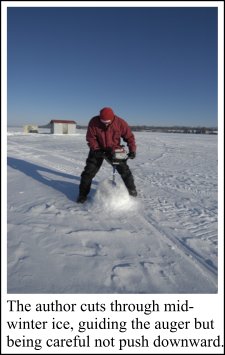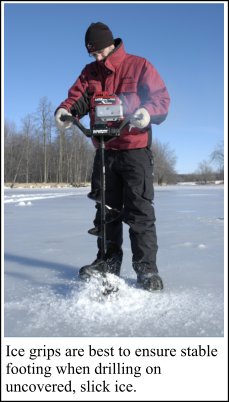Tips for Drilling Ice Holes The auger let out a steady 2-cycle scream as it chewed through a foot and a half of ice. Chips and shards fell around my feet until the blades broke through. I hit the throttle and cleared out the slush, before walking a few yards and punching another hole. Behind me my partner followed, checking the depth of water with a Vexilar. In 10 minutes we had several holes drilled, cleaned and scanned for depth. Now, we were ready to fish. Drilling holes may seem straightforward but there are some tricks of the trade that can make you more efficient when cutting the ice. Here are some suggestions for this upcoming hard-water season with a particular focus on powered augers.
Secure
Your Footing
"I found that with a chipper drill you need to put just enough down pressure to make the drill cut without over loading the power head," said Cyril Zieglmeier of StrikeMaster Ice Augers. He explains that augers featuring blades, like their Lazer 224, behave differently than chipper-style drills. "With a Lazer drill you should never need to put down pressure on it. It should cut its best with no load or even pulling it up just a little, and adding a little bit more upward pressure as you feel the tip break through the bottom of the ice," he added.
Clean the Hole
This cleared area acts like a channel, directing
slush and water away from the hole as you run and remove the auger. The
remaining snow around the hole directs water to the channel and prevents
additional snow and slush from entering the hole. "This approach usually
gets almost all the slush out," Genz noted.
Keep the Blades Clean Genz recommends clearing a section of snow away on the ice before putting your auger down. This way you can place the blades on ice and not in the snow. This prevents snow from sticking and freezing to the blades. Zieglmeier suggests laying an auger in the sun. He explained that this helps keep the drill warmer than when stored in the shade, and in some cases may provide enough heat to keep ice from forming on the blades. Should ice accumulate on the blades, which is often unavoidable in extremely cold conditions and when drilling lots of holes, it's best to remove it before running the unit. The Genz Tool is a good product that has a chipper at one end and a scoop at the other. A small hammer is just as effective. Tap the bottom of the blades (not the edges) to remove ice from the blades. In most cases, the ice shatters right off. Using a tool with a handle is a safe way to clear ice and keep your hands away from the auger's sharp blades. Lastly, never drill the auger halfway through the ice and use this half-hole as storage. This practice is not recommended by manufactures as the drill could freeze in place and removing it could result in damage to the drill or the power head. Try these hole-cutting tips on your next outing. Not only will you be more efficient at getting through the ice, but you'll spend less time drilling and cleaning, and more time jigging and hooking fish.
|


 Let the Blades do the Cutting
Let the Blades do the Cutting "One
thing that works really well after you drill through the ice, is to kick
the snow away from one side of the hole. Then run the auger again as you
lift it out," Genz said. He explains that you don't clear the entire mound
of ice shards away, only a section.
"One
thing that works really well after you drill through the ice, is to kick
the snow away from one side of the hole. Then run the auger again as you
lift it out," Genz said. He explains that you don't clear the entire mound
of ice shards away, only a section.